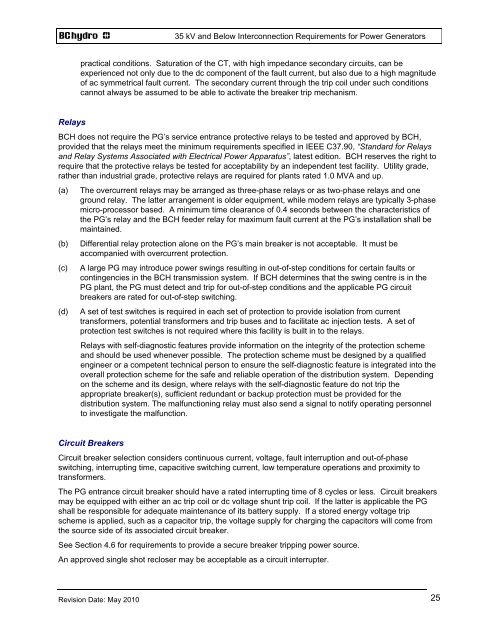35 kV and Below INTERCONNECTION REQUIREMENTS - BC Hydro
35 kV and Below INTERCONNECTION REQUIREMENTS - BC Hydro
35 kV and Below INTERCONNECTION REQUIREMENTS - BC Hydro
Create successful ePaper yourself
Turn your PDF publications into a flip-book with our unique Google optimized e-Paper software.
Revision Date: May 2010<br />
<strong>35</strong> <strong>kV</strong> <strong>and</strong> <strong>Below</strong> Interconnection Requirements for Power Generators<br />
practical conditions. Saturation of the CT, with high impedance secondary circuits, can be<br />
experienced not only due to the dc component of the fault current, but also due to a high magnitude<br />
of ac symmetrical fault current. The secondary current through the trip coil under such conditions<br />
cannot always be assumed to be able to activate the breaker trip mechanism.<br />
Relays<br />
<strong>BC</strong>H does not require the PG’s service entrance protective relays to be tested <strong>and</strong> approved by <strong>BC</strong>H,<br />
provided that the relays meet the minimum requirements specified in IEEE C37.90, “St<strong>and</strong>ard for Relays<br />
<strong>and</strong> Relay Systems Associated with Electrical Power Apparatus”, latest edition. <strong>BC</strong>H reserves the right to<br />
require that the protective relays be tested for acceptability by an independent test facility. Utility grade,<br />
rather than industrial grade, protective relays are required for plants rated 1.0 MVA <strong>and</strong> up.<br />
(a) The overcurrent relays may be arranged as three-phase relays or as two-phase relays <strong>and</strong> one<br />
ground relay. The latter arrangement is older equipment, while modern relays are typically 3-phase<br />
micro-processor based. A minimum time clearance of 0.4 seconds between the characteristics of<br />
the PG’s relay <strong>and</strong> the <strong>BC</strong>H feeder relay for maximum fault current at the PG’s installation shall be<br />
maintained.<br />
(b) Differential relay protection alone on the PG’s main breaker is not acceptable. It must be<br />
accompanied with overcurrent protection.<br />
(c) A large PG may introduce power swings resulting in out-of-step conditions for certain faults or<br />
contingencies in the <strong>BC</strong>H transmission system. If <strong>BC</strong>H determines that the swing centre is in the<br />
PG plant, the PG must detect <strong>and</strong> trip for out-of-step conditions <strong>and</strong> the applicable PG circuit<br />
breakers are rated for out-of-step switching.<br />
(d) A set of test switches is required in each set of protection to provide isolation from current<br />
transformers, potential transformers <strong>and</strong> trip buses <strong>and</strong> to facilitate ac injection tests. A set of<br />
protection test switches is not required where this facility is built in to the relays.<br />
Relays with self-diagnostic features provide information on the integrity of the protection scheme<br />
<strong>and</strong> should be used whenever possible. The protection scheme must be designed by a qualified<br />
engineer or a competent technical person to ensure the self-diagnostic feature is integrated into the<br />
overall protection scheme for the safe <strong>and</strong> reliable operation of the distribution system. Depending<br />
on the scheme <strong>and</strong> its design, where relays with the self-diagnostic feature do not trip the<br />
appropriate breaker(s), sufficient redundant or backup protection must be provided for the<br />
distribution system. The malfunctioning relay must also send a signal to notify operating personnel<br />
to investigate the malfunction.<br />
Circuit Breakers<br />
Circuit breaker selection considers continuous current, voltage, fault interruption <strong>and</strong> out-of-phase<br />
switching, interrupting time, capacitive switching current, low temperature operations <strong>and</strong> proximity to<br />
transformers.<br />
The PG entrance circuit breaker should have a rated interrupting time of 8 cycles or less. Circuit breakers<br />
may be equipped with either an ac trip coil or dc voltage shunt trip coil. If the latter is applicable the PG<br />
shall be responsible for adequate maintenance of its battery supply. If a stored energy voltage trip<br />
scheme is applied, such as a capacitor trip, the voltage supply for charging the capacitors will come from<br />
the source side of its associated circuit breaker.<br />
See Section 4.6 for requirements to provide a secure breaker tripping power source.<br />
An approved single shot recloser may be acceptable as a circuit interrupter.<br />
25
















